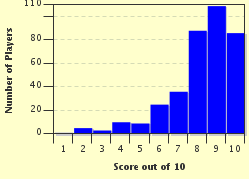Quiz Answer Key and Fun Facts
1. In 1940, Ralph Edwards started a radio game show based on the premise that contestants would be unable to answer a trivia question, and would therefore have to complete a humorous stunt. When the show moved to television, Edwards announced as a publicity stunt that the show would be broadcast from the first town or city to rename itself after the show, and subsequently did so from a town formerly known as Hot Springs, New Mexico. What was the name of this show?
2. The inimitable Groucho Marx was the host of a game show in which the actual game play was almost incidental - it was more a platform to allow him to display his ability to ad lib. In which game show did we see a rubber duck (wearing so-called "Groucho glasses" and holding a cigar in its beak) descend to award players with a cash bonus if they said the day's secret word?
3. In 1952, a game show debuted on NBC radio, later moving to NBC television in 1953, in which two contestants listened to the studio band. When a contestant recognized the piece of music being played, they ran across the stage to hit a large bell and identify the music. What was the name of this show, which had revivals in the 1970s and 1980s, as well as versions in other countries such as Australia and Italy?
4. The game show gurus Mark Goodson and Bill Todman produced a game show created by Bob Stewart in which contestants needed to know the value of a variety of items as they bid against each other. Bill Cullen hosted the original run, from 1956 through 1965; the 1972 revival was hosted by Bob Barker until Drew Carey took over in 2007. Which consumer-oriented show is being described?
5. What was the name of the game show, first appearing in 1958, based on the children's card game Memory combined with a rebus to be solved by contestants?
6. From 1961 until 1967 Allen Ludden hosted a game show in which two celebrities were each paired with a contestant in a word game. One player was given a word, and had to provide one-word clues to help their partner guess the secret word. If they didn't guess it correctly, or if an illegal clue was used, play passed to the other team. A maximum of ten clues, each worth fewer points, could be used for each word. What was the name of this show?
7. In 1961 and 1962 a short-lived game show asked contestants to locate and trace an image hidden in a picture with lots of distracting lines and images. They earned the chance to trace the hidden object by being first to buzz in and correctly answer a true-false question as the timer counted down the time allowed. Which of these was its name?
8. Between 1962 and 1967, the sound of 'A Swinging' Safari' by Bert Kaempfert introduced a game show hosted by Gene Rayburn in which two teams, each featuring one celebrity, would try to provide the same answer to a question such as "Name a kind of pie." After 1963, the show introduced more quirky, often suggestive, questions. Which of these is the name of this show?
9. The 1965 pilot for a show that subsequently ran on NBC from 1966 until 1981 featured Cliff Arquette, Wally Cox, Rose Marie, Morey Amsterdam, Abby Dalton, Jim Backus, Gisele MacKenzie, Robert Q. Lewis and Vera Miles sitting in nine cubicles arranged in a 3x3 grid. They answered questions asked by Peter Marshall, and players tried to decide whether the celebrity had answered correctly or was bluffing. What was this game called?
10. In 1983, what CBS game show introduced audiences to the "Whammy"?
Source: Author
looney_tunes
This quiz was reviewed by FunTrivia editor
kyleisalive before going online.
Any errors found in FunTrivia content are routinely corrected through our feedback system.

